Our friend Richard Sherman turned 90 last week! Let’s celebrate the impact he and his brother Robert had on the Disney record company with their landmark score.
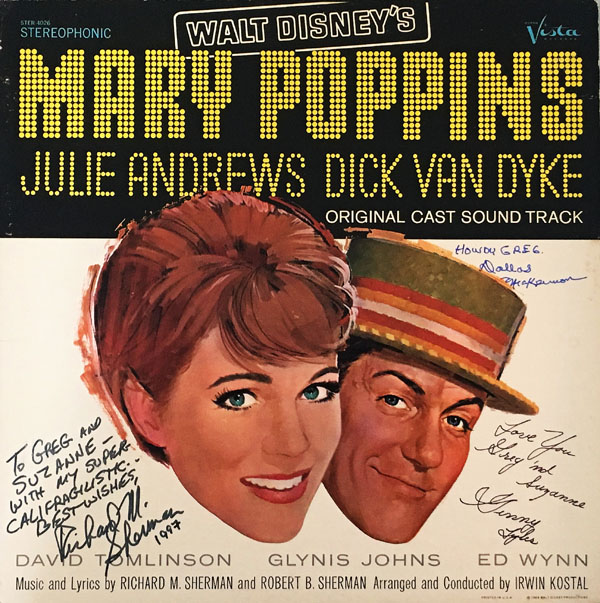
Walt Disney’s MARY POPPINS
Original Cast Sound Track
Buena Vista Records BV-4026 (Mono) STER-4026 (Stereo) (12” 33 1/3 RPM / Gatefold)
LP Reissue: STER-5003 (1973)
CD Reissues: CD-016 (1991); #60615-7 (1997); #61202-7 (2-Disc Anniversary Edition, 2004); D002036296 (3-Disc Legacy Collection Edition, 2014)
Released in March, 1964. Producer: Jimmy Johnson. Assistant Producer: Evelyn Kennedy. Music Supervisor/Arranger/Conductor: Irwin Kostal. Engineers: Bruce Botnick, Brian Ross-Myring. Album Produced at Sunset Sound Recorders, Hollywood. Running Time: 44 minutes.
Performers: Julie Andrews (Mary Poppins, Pearlies); Dick Van Dyke (Bert, Mr. Dawes, Sr.); Ed Wynn (Uncle Albert); David Tomlinson (George Banks); Glynis Johns (Winifred Banks); Karen Dotrice (Jane Banks); Matthew Garber (Michael Banks); Arthur Malet (Mr. Dawes, Jr.); J. Pat O’Malley (Pearly Drummer); Bill Lee, Ginny Tyler, Marni Nixon, Thurl Ravenscroft, Paul Frees, Marc Breaux (Barnyard Animals); Richard and Robert Sherman (Pearlies).
Songs: “The Perfect Nanny,” “Sister Suffragette,” “The Life I Lead,” “A Spoonful of Sugar,” “Pavement Artist (Chim Chim Cheree),” “A Jolly Holiday,” “Supercalifragilisticexpialidocious”,” “Stay Awake,” “I Love to Laugh,” “A British Bank (The Life I Lead),” “Feed the Birds,” “Fidelity Fiduciary Bank,” “Chim Chim Cheree,” “Step in Time,” “A Man Has Dreams (The Life I Lead/A Spoonful of Sugar),” “Let’s Go Fly a Kite” by Richard M. Sherman, Robert B. Sherman.
Instrumental: Overture (with Chorus).
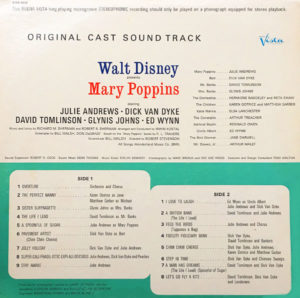 It’s one thing to make a major film musical based on an established stage production, it’s another thing entirely to try out a fresh, new set of songs in a big, splashy live-action musical. That’s risky even for the bigger studios, who by the early ‘60s, were not doing very many of them anymore—and if they were, the properties were almost always sure things, like Broadway hits. Warner Brothers had done well with The Music Man and were working on My Fair Lady, perhaps the biggest stage musical of its day.
It’s one thing to make a major film musical based on an established stage production, it’s another thing entirely to try out a fresh, new set of songs in a big, splashy live-action musical. That’s risky even for the bigger studios, who by the early ‘60s, were not doing very many of them anymore—and if they were, the properties were almost always sure things, like Broadway hits. Warner Brothers had done well with The Music Man and were working on My Fair Lady, perhaps the biggest stage musical of its day.
It’s staggering to consider what a brazen move it must have seemed to the major studios when Walt Disney decided to take on a “big” musical with an original score—penned by two young songwriters who had never tackled a Broadway show before, or a live TV musical like Rodgers and Hammerstein’s Cinderella. In addition to their early pop music career, by the early ’60s the Sherman brothers had written all the songs for the 1963 animated feature The Sword in the Stone; several Disney TV shows including the theme for the Wonderful World of Color; hit Hayley Mills films like The Parent Trap and top ten hits for Mouseketeer turned movie star Annette.
Walt let their talent speak for itself. The industry excitement for Mary Poppins the score grew as big as it was for Mary Poppins the movie. Roy O. Disney was suddenly in discussion with the major record labels like RCA Victor and Columbia, clamoring for the rights to the soundtrack album. Roy was fully aware that he and his brother Walt had their own record company, but he was entertaining the idea of allowing the larger outside companies the permission to release Mary Poppins albums.
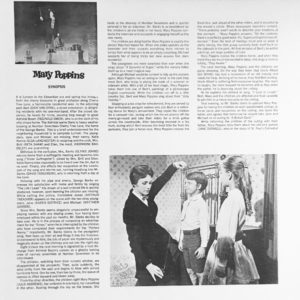 Disneyland Records President Jimmy Johnson was feeling the pressure of this decision. Roy had allowed him to create Disneyland Records and its sister label, Buena Vista. The first three years were rough, so much so that Walt and Roy had considered shutting the record division down. But because of Annette’s hit records for Buena Vista and a more profitable kid-based product line for Disneyland, things were holding on. Jimmy had to convince Roy that their small-but-plucky operation was as effective as the big labels.
Disneyland Records President Jimmy Johnson was feeling the pressure of this decision. Roy had allowed him to create Disneyland Records and its sister label, Buena Vista. The first three years were rough, so much so that Walt and Roy had considered shutting the record division down. But because of Annette’s hit records for Buena Vista and a more profitable kid-based product line for Disneyland, things were holding on. Jimmy had to convince Roy that their small-but-plucky operation was as effective as the big labels.
The subsequent success of Mary Poppins impacted every square inch of the Disney organization, including the record company. For the first time, it stood on solid ground–and continues to thrive today–largely due to the fact that Johnson, the Shermans and Tutti Camarata (whose Sunset Sound studio produced the album) not only put together a powerhouse album, but also created a line of Poppins audio products that sold for years and became creative and sales benchmarks. Along with Fantasia and Snow White and the Seven Dwarfs, the Mary Poppins album has been inducted into the National Academy of Recording Arts and Sciences Hall of Fame.
Mary Poppins may have added one other footnote to recording history with the unique phrase listed on the album cover. While Jimmy Johnson does not mention it in his autobiography, it is very likely that he, the Shermans and/or Camarata came up with the words “Original Cast Sound Track.” As of this writing, no other film score recording before Mary Poppins bears that particular nomenclature. It was used on only three more Disney albums: The Happiest Millionaire; The One & Only, Genuine, Original Family Band; and Bedknobs and Broomsticks. The Sherman brothers brought the term with them to United Artists Records for their Chitty Chitty Bang Bang “Original Cast Soundtrack.”
 Perhaps “Original Cast Sound Track” was intended to underscore that, in a confusing marketplace, that the consumer could absolutely be sure of getting inside what was promised on the outside. At the time of Mary Poppins’ release, a lot of press was given to the ghost singing of Marni Nixon for Audrey Hepburn in My Fair Lady and for Natalie Wood in West Side Story. The album covers for those soundtrack albums credit Ms. Hepburn and Ms. Wood as the stars, because they starred in the films, not the recordings. So, if you bought West Side Story with Natalie Wood and Richard Beymer’s name on the front–which was legal and accurate–you take it home and listen to Marni Nixon and Jimmy Bryant. BUT, the “Original Cast Sound Track” clearly states that Julie Andrews and Dick Van Dyke will really be singing on the Mary Poppins record. (Ironically, Marni Nixon recorded Disneyland’s excellent studio cast version of the Poppins songs, which dutifully listed her on the cover—we talked about that album here.
Perhaps “Original Cast Sound Track” was intended to underscore that, in a confusing marketplace, that the consumer could absolutely be sure of getting inside what was promised on the outside. At the time of Mary Poppins’ release, a lot of press was given to the ghost singing of Marni Nixon for Audrey Hepburn in My Fair Lady and for Natalie Wood in West Side Story. The album covers for those soundtrack albums credit Ms. Hepburn and Ms. Wood as the stars, because they starred in the films, not the recordings. So, if you bought West Side Story with Natalie Wood and Richard Beymer’s name on the front–which was legal and accurate–you take it home and listen to Marni Nixon and Jimmy Bryant. BUT, the “Original Cast Sound Track” clearly states that Julie Andrews and Dick Van Dyke will really be singing on the Mary Poppins record. (Ironically, Marni Nixon recorded Disneyland’s excellent studio cast version of the Poppins songs, which dutifully listed her on the cover—we talked about that album here.
The Buena Vista vinyl LP was first issued in stereo and mono editions. Mono versions were traditionally mixed by the engineer so that certain elements could be heard better through one channel, but sometimes engineers would make other changes that inspire collectors to seek out both versions. In the case of “Step in Time,” Dick Van Dyke is louder in a later chorus than he is in the stereo version.
The LP was reissued in 1973 with what some fans call the “Cyd Charisse” art that was part of the film’s first major theatrical reissue. Rather than update the liner notes, as Walt had passed since the first release, the gatefold was eliminated entirely. Mary Poppins was one of the earliest—certainly the most requested—Disney compact discs, the first adding on demo material with explanations by Shermans. Next came a two-disc set with sumptuous underscoring lovingly restored by Walt Disney Records Producer Randy Thornton, along with actual story meetings between the Shermans and the prickly Ms. Travers. The most recent—and ever so lovely—Legacy Collection includes a hardcover book with rare art, great notes, all the music from the above CD’s, plus Irwin Kostal’s extended Overture from the vinyl LP, a radio interview and those superb “Lost Chords” songs that we discussed in this Spin.
Debbie Reynolds, who would interpret some of the Shermans’ greatest songs a few years later in 1973’s Charlotte’s Web, presented one of the brothers’ two wins for Mary Poppins that Oscar night:
The 45 RPM Single of “Supercalifragilisticexpialidocious”
It was possible to purchase single versions of the soundtrack and the studio versions of the songs. Even a few of the last Disney 78 RPM records were Mary Poppins songs. This vinyl version of “Supercalifragilisticexpialidocious” is a little different from the CD version with regard to sound effects.
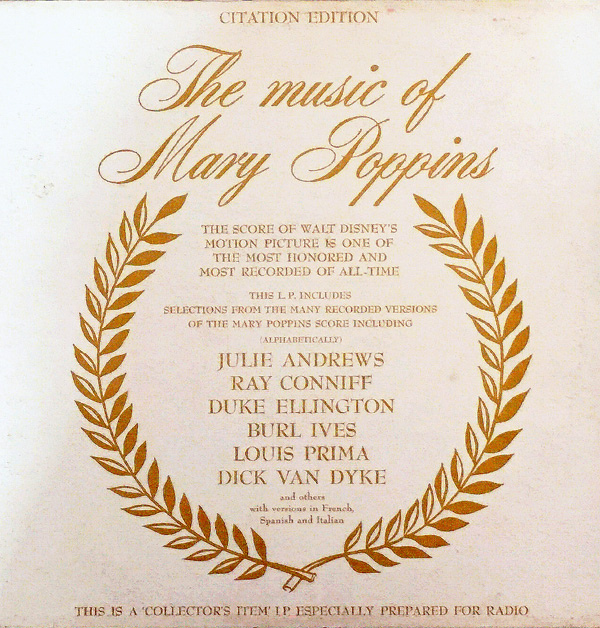
THE MUSIC OF MARY POPPINS
Selections from the Many Recorded Versions of the Mary Poppins Score
Wonderland Music Company, Inc. (Promotional Only) WOND-1-4026 (Mono) (12” 33 1/3 RPM)
Released in 1965. Music and Lyrics: Richard M. Sherman, Robert B. Sherman. Producer: Jimmy Johnson. Album Produced at Sunset Sound Recorders, Hollywood. Running Time: 35 minutes.
Performers and Songs:
Ray Conniff and the Singers: “A Spoonful of Sugar,” “Feed the Birds”
Duke Ellington: “Chim Chim Cheree,” I Love to Laugh”
Burl Ives: “Chim Chim Cheree”
Louis Prima: “Stay Awake,” “Supercalifragilistic-espiraalidoso” (Italian)
Christiane Legrand: “Sister Suffragette” (French)
Bob Martin: “The Life I Lead” (French)
Los Tres Con Ella: Supercalifragilistico-espialidoso” (Spanish)
Big Ben Banjo Band (The Mike Sammes Singers): “Jolly Holiday” (UK Import)
Soundtrack Selections:
Julie Andrews: “Stay Awake”
Dick Van Dyke (with Karen Dotrice & Matthew Garber): “Chim Chim Cheree”
Julie Andrews & Dick Van Dyke: “Supercalifragilisticexpialidocious”
Jimmy Johnson was taking no chances on missing a single possible buyer or seller for the score of Poppins. This album was created as part of a massive campaign to alert radio stations of the songs, but also to encourage recording artists to make their own versions. The sheet music sales for Mary Poppins were highly profitable too, with schools, community centers, bands in the mix as well as professional musicians and singers.
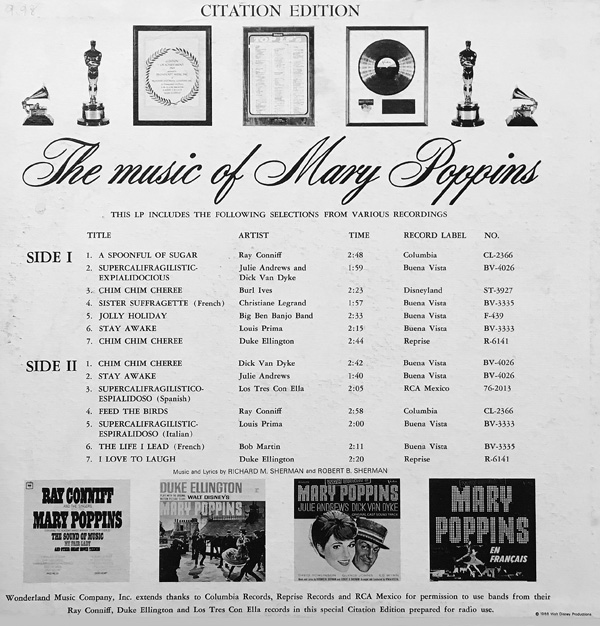
“A Spoonful of Sugar” – Ray Conniff and the Singers
It’s such grand, kooky fun to hear the singers actually sing about the movie itself at the beginning of this version of the tune—and to suggest that you go see it! “Two tickets to Mary Poppins please, Mr. Theater Box Office Ticket Seller–for you see, I was instructed to see it by those people-in-the-know who sang ‘Invisible Tears.’”


 GREG EHRBAR is a freelance writer/producer for television, advertising, books, theme parks and stage. Greg has worked on content for such studios as Disney, Warner and Universal, with some of Hollywood’s biggest stars. His numerous books include Mouse Tracks: The Story of Walt Disney Records (with Tim Hollis). Visit
GREG EHRBAR is a freelance writer/producer for television, advertising, books, theme parks and stage. Greg has worked on content for such studios as Disney, Warner and Universal, with some of Hollywood’s biggest stars. His numerous books include Mouse Tracks: The Story of Walt Disney Records (with Tim Hollis). Visit 





















































Whoa! Did you just say 90?
Possibly the best Mary Poppins cover was John Coltrane’s take on Chim-Chim – Cher-ee. Me,I love Philly’s Rufus Harley’s take with jazz bagpipe-from Bagpipe Blues. Wes Montgomery’s take,has a very busy full blown band arrangement by Oliver Nelson(arrangers on Wes’ albums added the background after Wes recorded his part with a small group). I usually love Ollie’s work,but I would love to hear just Wes.
By 1964 I was a couple years into my incremental progress to audiophiledom (it would take another five years and my first real job before I could start going crazy) and as the stylus tracked the overture/main title I got immediate goosebumps – not just from the music, but I thought it was the best sound I’d heard yet coming through my system.
Thanks so much, Greg, for this excellent tribute to a very special time in recording. And thanks for the links. Ray Conniff and Singers track had me laughing and singing. Of course, one of my favorite tracks that finally got added to the CD collection (3) was the Buena Vista open. It was a slower take. Is the take used in the movie included somewhere else? I need to get that 2-Disc set. I had never heard of it till now. Another favorite is the complete Overture with that grand ending. I’m sure you understand how I feel about it. As a kid, I would dream it was actually part of some overture they used at the time, but I know it was just for the LP. But I can imagine folks in the audience softly talking while the overture plays, and then that grand ending happens. I fantasize about someone thinking “Damn, this is important. A really big deal. I wish I had been paying more attention.” Thanks again for the great work, Greg. I always feel very satisfied reading your articles and Facebook posts.
I deeply appreciate your nice comments, Kevin. As to the take used in the movie, I thought it was the one on the CD, at least it sounded that way to me. The extension on the overture did come in handy when the studio needed music for promotional films and commercial spots. Several commercials ended with the final notes of the LP overture.
Despite Disneyland Records’s firmness in the face of competition, I had a RCA Record Club pressing.
Yes, you are correct Keith. RCA Victor licensed an identical Mary Poppins albums for their record club using the Sunset Sound masters. The only difference about it was the label on the disc itself, the catalog number and the pink color of Julie Andrews’ and Dick Van Dyke’s names on the cover. Nevertheless it was still Buena Vista’s packaging and their win. Thanks for mentioning it here, as it can be a confusing item.
Greg, this is a terrific article, erudite and comprehensive as usual! I’ve pinned it to the top of the Sherman Brothers’ Facebook page because everyone should read it! It is remarkable how many covers there were of this soundtrack (in one form or another). I think about ten years ago I counted over two hundred! You’d never get that kind of number today!
Wow. Thanks very much, Robert!
I have a RCA Victor pressing of Mary Poppins, with CSO-111 as the serial number. Is this a pressing for the record club, as stated in a prior post? Is there any value to the RCA Victor recordings? The Names of Julie Andrews and Dick Van Dyke are in pink, as stated earlier.
Fewer may have been made than the Buena Vista version, and they may be of interest to some collectors and completists, but I would not say it would be of special value, as the album was so popular that RCA also sold many copies and RCA was and is a very, very big record label.
The thing to remember about collecting is that the true value lies in what someone else wants to pay, not in what it is inherently worth. The true and lasting worth is in what it does for those who sincerely love it and that is beyond measure.